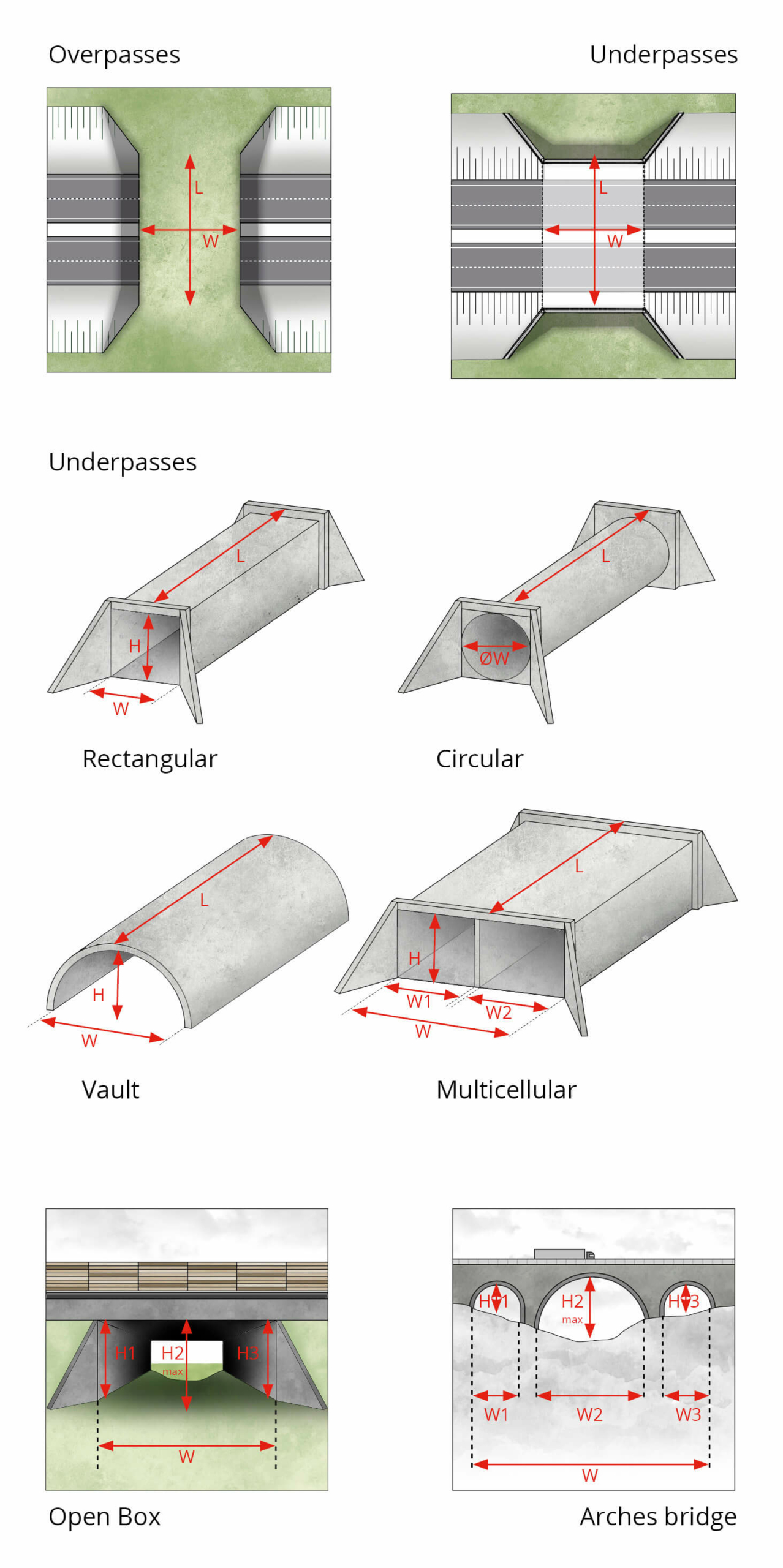The naming of structures differs between countries. Most commonly used names in Europe are provided in this chapter.
Wildlife passages can be divided in two main groups depending if they are located above the infrastructure (overpasses) or below the infrastructure (underpasses). Innovative at level passages are also being implemented.
Types of wildlife passage are defined in this handbook based on their ecological function, i.e. to provide links which connect ecosystems or to provide crossing opportunities for wildlife or particular target species. Names for these passages should not be confused with construction engineering terminology used in infrastructure design. E.g. a ‘landscape overpass’ is a type of wildlife passage that can be provided by a bridge, a cut-and-cover tunnel or even by an excavated tunnel (construction types).
Overpasses
Overpasses may provide safe wildlife crossing and habitat connections above transport infrastructure platforms. Many types are specific for wildlife and landscape connections but also structures which were primarily designed for forestry roads, cattle or pedestrian trails may be adapted and maintained to provide a passage for wildlife.
There are four types of wildlife overpasses:
Landscape overpass; Ecoduct; Green bridge
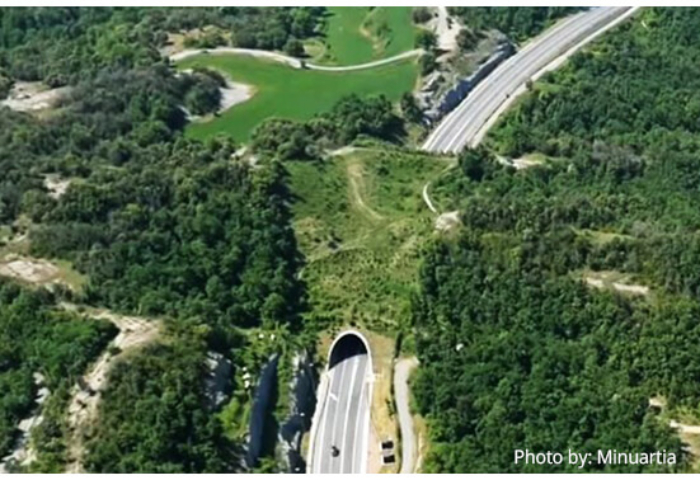
Landscape overpasses are large structures over transport infrastructure to provide continuity of habitats from both sides. Due to their width, a diversity of habitat types (e.g. vegetation or soil types, stone rows or piles, ponds, etc.) could be included. Combined with perimeter fencing that funnels the animals to the structure and with light/noise screens to reduce disturbance by traffic when required. The main difference to wildlife overpasses is their width and possibilities for vegetation cover and diversity of habitats being created which facilitate better ecosystem connection. Landscape overpasses can also be constructed over cut-and-cover or excavated tunnels.
Wildlife overpass; Fauna overpass
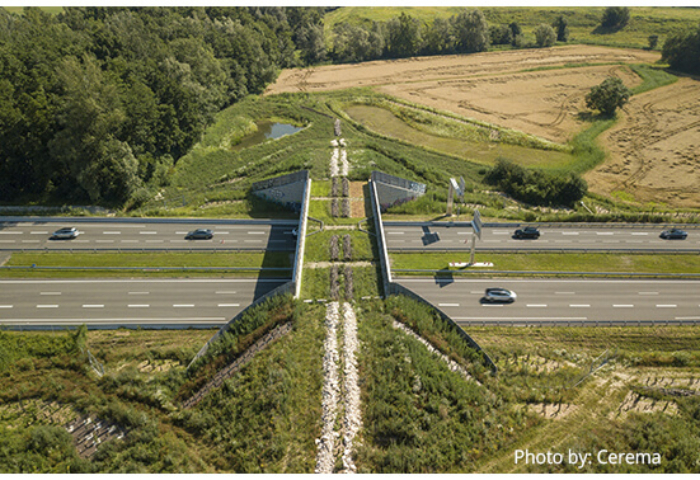
Wildlife overpasses are structures built over transport infrastructure specifically to provide a safe crossing point for wildlife and to connect habitats from both sides. The surface is covered with natural materials and soil allowing the growth of different species of vegetation. Other refuges for fauna such as stone or wood rows can also be installed. Combined with perimeter fencing that funnels the animals to the structure and with light/noise screens to reduce disturbance when required. While similar to landscape overpasses, they are narrower, limiting the extent to which different habitats and vegetation can be included on the structure.
Multiuse overpass
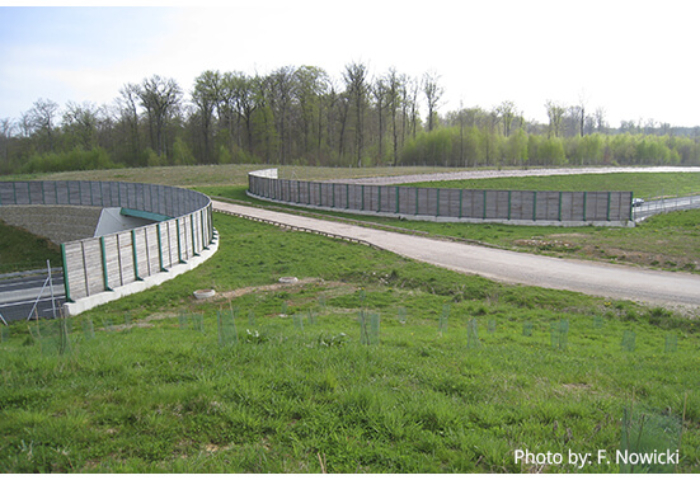
Multiuse overpasses are structures built over transport infrastructure with multiple functions including the movement of fauna. It combines wildlife and human uses such as small forestry roads, cattle passages or pedestrian paths. Modifications are included to encourage use by wildlife such as addition of strips covered by natural materials and vegetation, and screens to reduce traffic disturbance when required. Combined with perimeter fencing that funnels the animals to the structure.
Tree-top overpass; Canopy bridge
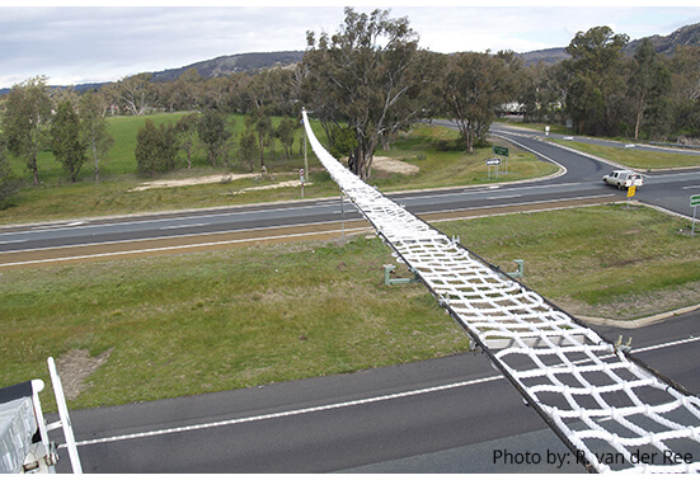
Tree-top overpasses consist of rope, net or pole suspended above transport infrastructure from vertical poles or trees, for arboreal and scansorial species. While fencing would improve rates of use, fence designs are yet to be developed due to the climbing ability of the target species. Similar structures have been proposed for bats, the success of which has yet to be demonstrated.
Underpasses
Underpasses may provide safe wildlife crossing and habitat connections below transport infrastructure platforms. Many underpasses are primarily constructed for drainage, forestry roads, cattle or pedestrian trails but can be adapted and maintained to provide a passage for wildlife also.
There are six types of wildlife underpasses:
Adapted viaduct; Landscape underpass
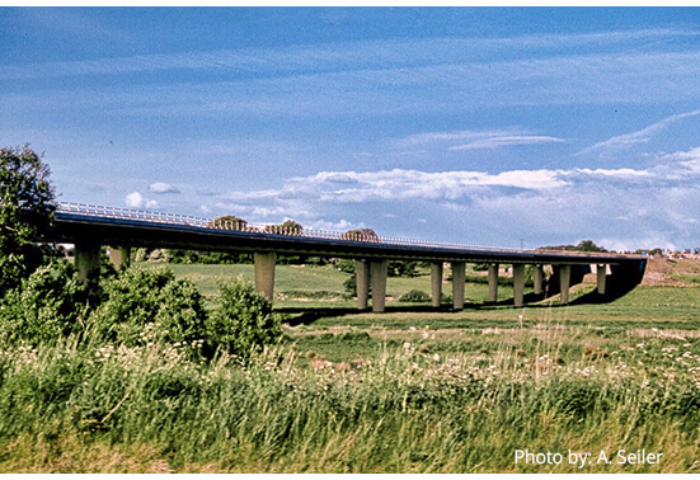
Adapted viaducts are large structures, usually supported by pillars or arches, which carry transport infrastructure and enable the preservation of valuable ecosystems and ecological corridors below the structure. Preservation and restoration of continuous terrestrial, riparian and aquatic habitats below viaducts facilitate movement of multiple vertebrate and invertebrate species. Land uses and activities under the structure must be compatible with fauna movements and preservation of ecological connectivity. Viaducts must not be considered as wildlife passages when human disturbance or infrastructure with high traffic volume is beneath. Combined with perimeter fencing that funnels the animals to the structure and with light/noise screens to reduce disturbance when required.
Wildlife underpass; Fauna underpass
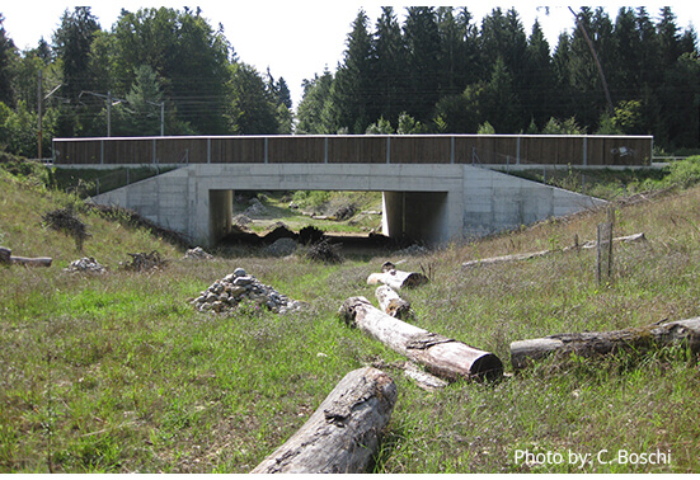
Wildlife underpasses are structures built under transport infrastructure specifically to provide a safe crossing point for wildlife, typically large and medium-sized mammals, such as ungulates and large carnivores, but also for other vertebrates and invertebrates. Construction types are predominantly box, vault or beam platform structures. The substrate is covered with natural materials and soil allowing different species of vegetation growth where there is enough light and humidity. Elements such as stone rows may provide wildlife refuges inside. Combined with perimeter fencing that funnels the animals to the structure and with light/noise screens to reduce disturbance when required. Depending on underpass dimensions, they may be suitable for different groups of animals. Note: to be suitable for amphibians in migration, these structures may require specific fencing (see Section 5.5.13 – Amphibian passages).
Multiuse underpass
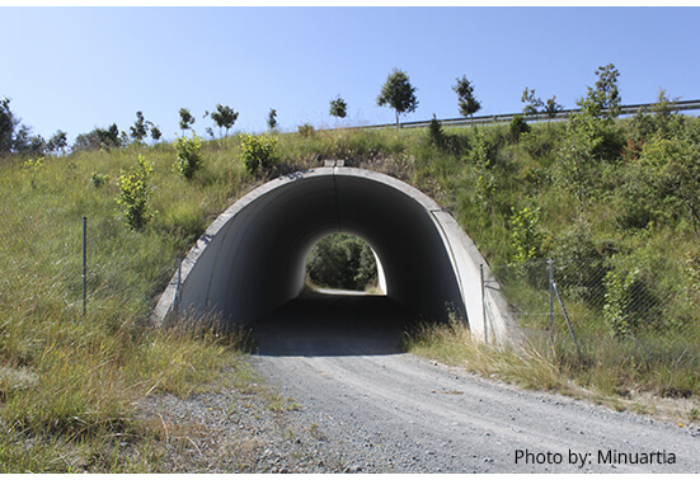
Multiuse underpasses are structures built under transport infrastructure with multiple functions including the movement of fauna. It combines wildlife and human uses such as small forestry roads, cattle or pedestrian passages. A drainage function including streams or other small waterways inside the structure is also compatible and may even lead fauna through the passage. These underpasses may include modifications to increase wildlife use such as fencing to funnel the animals, adaptation of vegetation at the entrances and measures to avoid excessive pooling of water. Combined with perimeter fencing that funnels the animals to the structure and with screens to reduce light and noise disturbance from traffic when required
Small fauna underpass
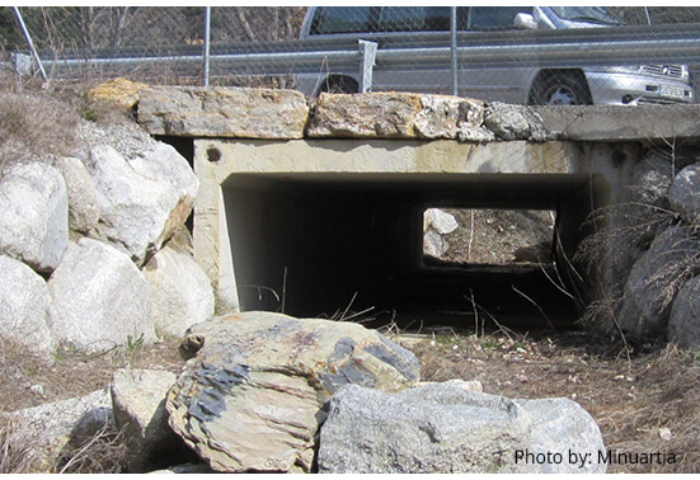
Small fauna underpasses are structures built under transport infrastructure designed specifically to provide a safe crossing point for small fauna such as reptiles, small mammals or invertebrates which are used to dark, humid habitats. Construction types are predominantly box or vault structures. Combined with perimeter fencing that funnels the animals to the structure and with light/noise screens to reduce disturbance when required. Depending on underpass size, these are also suitable for larger animals. Note: to be suitable for amphibians in migration, these structures may require specific fencing Section 5.5.3 – Amphibian passages).
Adapted culverts
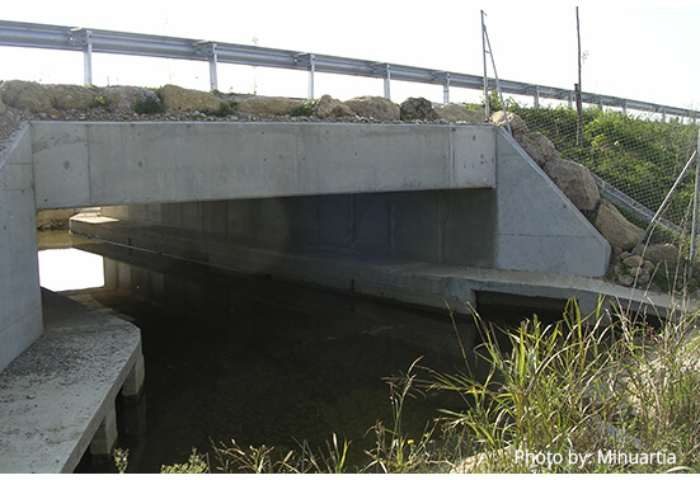
Adapted culverts are modified pipes or box culverts that allow a watercourse and/or drainage to flow underneath transport infrastructure and include adaptations to facilitate aquatic and terrestrial wildlife crossing. These often include dry ledges or shelves to provide dry passage, which are connected to adjacent habitats. The design and landscaping at the entrances is particularly adapted for the needs of wildlife, not only erosion control.
Fish passages
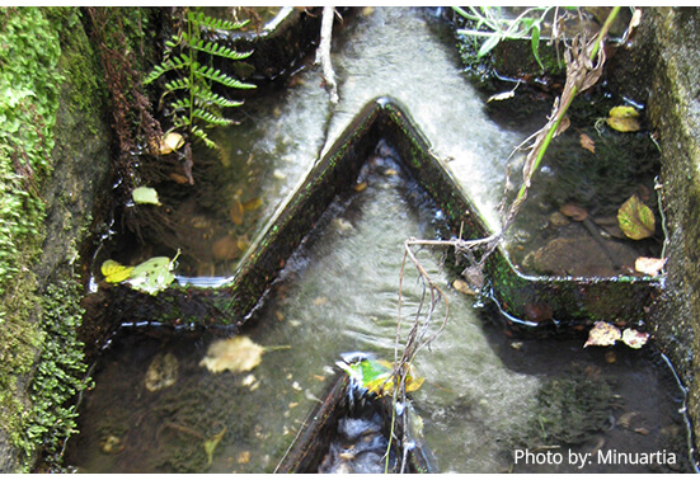
Fish passages are modified pipes or box culverts that allow a watercourse and/or drainage to flow underneath transport infrastructure and include adaptations to provide particular conditions that enable fish to swim through. When possible, adaptations for use by wildlife may also include dry ledges or shelves to provide passage for other terrestrial species, and which are connected to adjacent habitats.
Amphibian passages
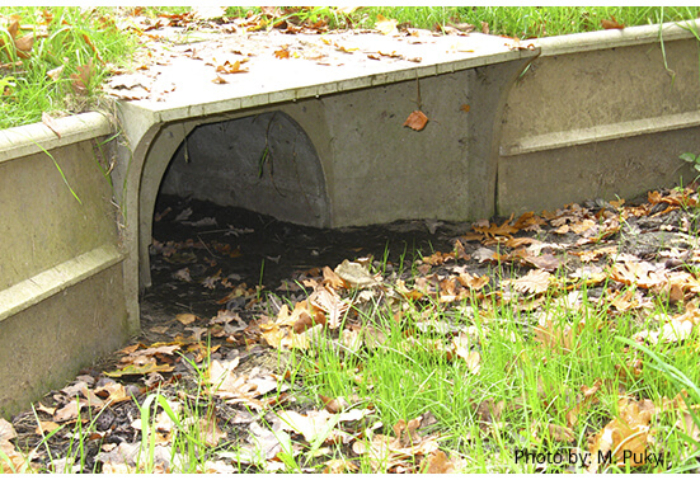
Amphibian passages are small structures built under transport infrastructure designed specifically to provide a safe crossing point for amphibians. Often consisting of multiple underpasses in close proximity to each other. Requires effective opaque fencing to intercept the amphibians and funnel them to the crossing structures.
Additionally, ‘bat crossing devices’ and ‘at grade fauna passage’ are also described even if further studies are required to establish their effectiveness.
Choice of the appropriate wildlife passage
The selection of the most appropriate type of wildlife passage requires consideration of the landscape, habitats affected and target species requirements. The importance of the habitats and species should be evaluated at a local, regional, national and international scale as part of an EIA (see Chapter 2 – Policy, strategy and planning). Preserving ecological connectivity -or restoring it where required- should be the goal, meaning a multi-species approach is to be preferred. In general, the more species depend on habitat connectivity, the more complex should be the mitigation measures to ensure effectiveness (Figure 5.5.1). Therefore, when transport infrastructure unavoidably creates a barrier to an important ecological corridor for long distance dispersal, ecoducts or adapted viaducts may be the only measure that can help to maintain functional connectivity.
In contrast, small adapted culverts or amphibian passages may be enough to maintain a migration corridor for a locally important population of small vertebrates (e.g., reptiles or amphibians). In practice, to effectively mitigate habitat fragmentation:
- A set of integrated measures for the whole infrastructure addressing problems at each specific site is required.
- The combination of diverse wildlife passage types combined with other measures, meeting the needs of a variety of target species or groups, will often be the best solution to reduce the barrier effect of transport infrastructure.
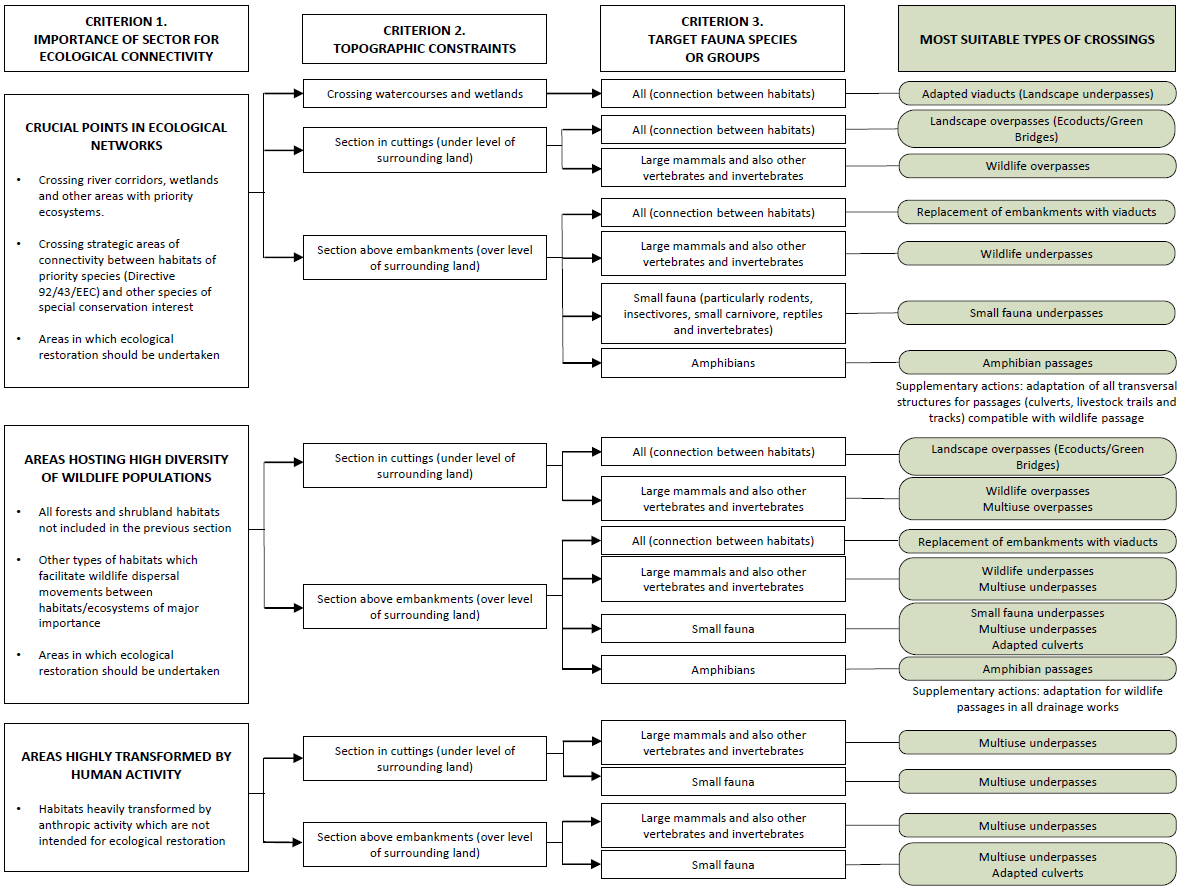
Target species
Even if a multi-species approach is to be preferred when designing wildlife passages, it is essential to clearly identify the main target species (Figure 5.5.2 and Table 5.2). Large mammals, amphibians or some particularly endangered species among vertebrates and invertebrates will require rather different types of structures.
- While any wildlife species could be designated a target species for wildlife passages, including invertebrates, there is a need to avoid facilitating Invasive Alien Species (IAS) as they cause damage to local biodiversity.
- Opportunities for all species in a territory to cross the infrastructure should be provided in its development. Identifying target species, their location and movement patterns are important steps in the process of planning the location and design of wildlife passages and planning monitoring procedures to evaluate the success of a passage (see Chapter 6 – Evaluation and monitoring and Chapter 7 – Maintenance).
- Target species are often endangered species, but also abundant large mammals which are frequently involved in animal-vehicle collisions posing a big threat to infrastructure safety. Both influence the position and type of passage design. Hotspots of wildlife mortality should be considered in a global analysis combined with information about other factors such as local wildlife population density. Mitigation measures are required not only in hotspots of road mortality and even in areas not identified as hotspots, but where a seemingly low wildlife mortality could be critical for the long term conservation of low density target species or local endangered populations.
- Even if target species are important in deciding if and where wildlife passages are necessary, the design of passages must follow a multispecies approach not just catering for the needs of only one single target species. Usage can be maximized and effectiveness increased by including the needs of a wide spectrum of species. For example, an overpass across a motorway that is built to preserve a migration route for red deer must also form a habitat connection for populations of other vertebrates (not only mammals, but also birds, amphibians and reptiles) and invertebrates (e.g. insects). Nevertheless, experience has shown that some designs are better suited to some particular species than others. Table 5.2 gives some indications for appropriate passage type which may reduce mortality and provide safe crossing points for particular species or groups of species.
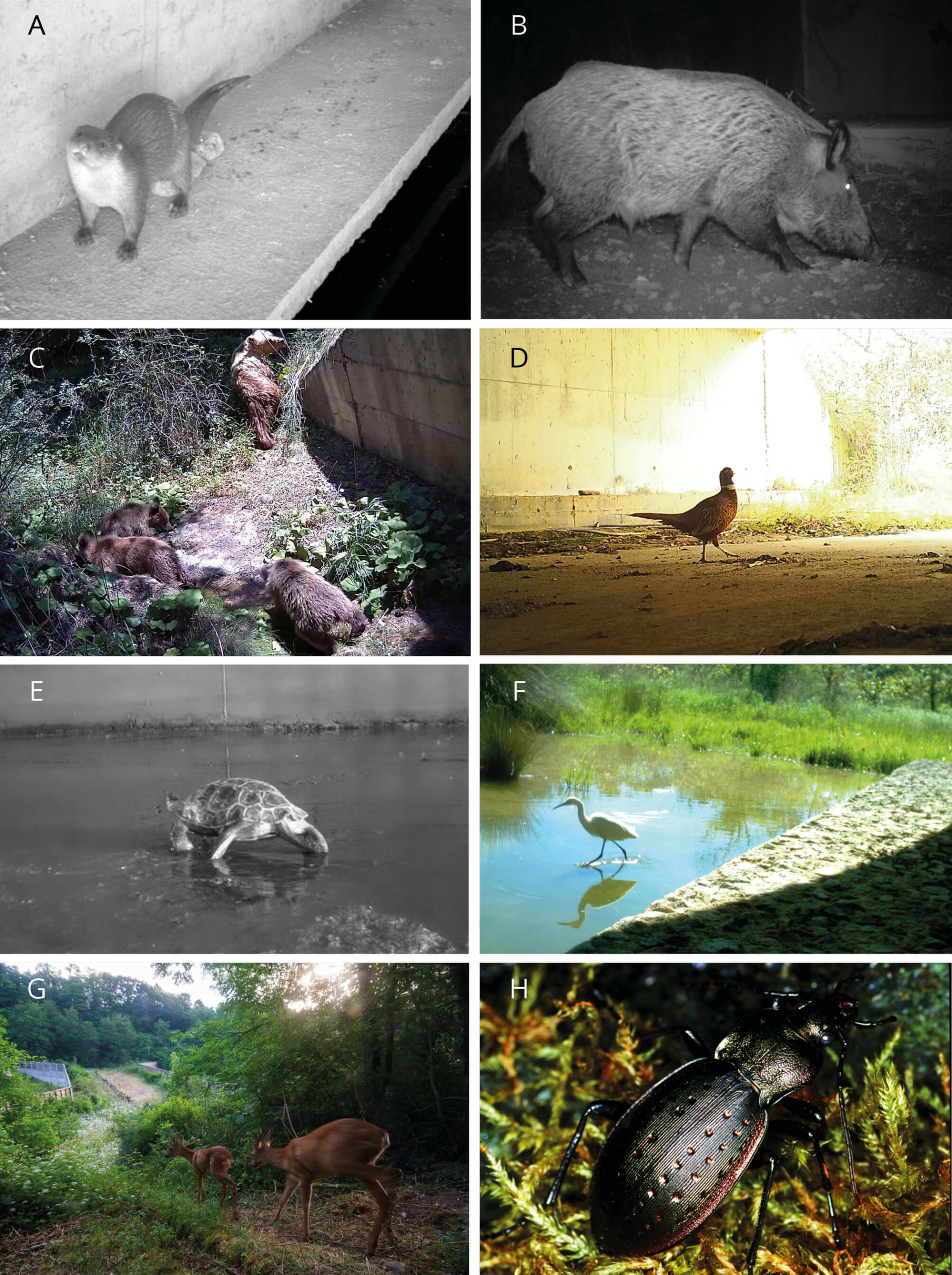
Table 5.2 – Suitability of different types of wildlife passages for a selection of species or groups of species.
| Landscape overpass (Ecoduct, Green Bridge) | Wildlife overpass (Fauna overpass) | Multiuse overpass | Tree-top overpass (Canopy bridge) | Adapted viaduct (Landscape underpass) | Wildlife underpass (Fauna underpass) | Multiuse underpass | Small fauna underpass | Adapted culvert | Fish passage | Amphibian passage | ||
| Moose, Red deer | ● | ● | ○ | ─ | ● | ● | ○ | ─ | ─ | ─ | ─ | |
| Roe deer, Chamois | ● | ● | ○ | ─ | ● | ● | ○ | ─ | ─ | ─ | ─ | |
| Wild boar | ● | ● | ○ | ─ | ● | ● | ○ | ─ | ○ | ─ | ─ | |
| Brown bear | ● | ● | ○ | ─ | ● | ● | ○ | ─ | ─ | ─ | ─ | |
| European lynx | ● | ● | ○ | ─ | ● | ● | ○ | ─ | ○ | ─ | ─ | |
| Wolf | ● | ● | ● | ─ | ● | ● | ● | ─ | ─ | ─ | ─ | |
| Fox | ● | ● | ● | ─ | ● | ● | ● | ● | ● | ─ | ─ | |
| Wildcat | ● | ● | ● | ? | ● | ● | ○ | ● | ● | ─ | ─ | |
| Badger | ● | ● | ● | ─ | ● | ● | ● | ● | ● | ─ | ─ | |
| Otter, European mink | ○ | ○ | ○ | ─ | ● | ● | ● | ● | ● | ─ | ─ | |
| Marten Stone marten | ● | ● | ● | ○ | ● | ● | ● | ● | ● | ─ | ─ | |
| Other small mustelid | ● | ● | ● | ─ | ● | ● | ● | ● | ● | ─ | ─ | |
| Genet | ● | ● | ● | ─ | ● | ● | ● | ● | ○ | ─ | ─ | |
| Hare | ● | ● | ● | ─ | ● | ● | ● | ○ | ○ | ─ | ─ | |
| Rabbit | ● | ● | ● | ─ | ● | ● | ● | ● | ○ | ─ | ─ | |
| Hedgehogs | ● | ● | ● | ● | ● | ● | ○ | ○ | ─ | ─ | ||
| Shrews | ● | ● | ● | ─ | ● | ● | ● | ● | ○ | ─ | ○ | |
| Red squirrel | ● | ● | ● | ● | ● | ● | ● | ─ | ─ | ─ | ─ | |
| Dormice | ● | ● | ○ | ● | ● | ? | ? | ─ | ─ | ─ | ─ | |
| Mice, voles | ● | ● | ● | ─ | ● | ● | ● | ● | ○ | ─ | ○ | |
| Beaver | ○ | ○ | ○ | ─ | ● | ● | ● | ● | ● | ─ | ─ | |
| Bats | ● | ● | ● | ─ | ● | ○ | ○ | ○ | ○ | ─ | ─ | |
| Snakes | ● | ● | ● | ─ | ● | ○ | ○ | ○ | ○ | ─ | ─ | |
| Lizards | ● | ● | ● | ─ | ● | ○ | ○ | ○ | ○ | ─ | ─ | |
| Tortoises | ● | ● | ● | ─ | ● | ○ | ○ | ○ | ─ | ─ | ─ | |
| Amphibians | ● | ○1 | ○1 | ─ | ●1 | ○1 | ○1 | ○1 | ○1 | ─ | ● | |
| Fish | ─ | ─ | ─ | ─ | ─ | ─ | ─ | ─ | ─ | ● | ─ | |
| Bird | ● | ● | ● | ─ | ● | ○ | ○ | ─ | ○ | ─ | ─ | |
| Invertebrates – dry habitats | ● | ● | ● | ─ | ● | ○ | ○ | ○ | ─ | ─ | ─ | |
| Invertebrates – forest, humid habitats | ○ | ○ | ○ | ─ | ● | ○ | ○ | ○ | ○ | ─ | ○ | |
1 If there is enough humidity and combined with opaque guiding fences.
Overpasses versus underpasses
When a wildlife passage must be constructed in a particular site, there are several general considerations which determine the choice of either an overpass or an underpass, the most important being the local topography, landscape, target species requirements and budget available.
- In hilly terrain it is often feasible to construct either type and the choice depends on the infrastructure section being crossed. Over embankments an underpass is preferred, while between cuttings an overpass is recommended.
- In flat landscapes overpasses are the best option. To raise the level of the infrastructure by placing it on a viaduct is an alternative but the associated cost is considerably higher.
- Overpasses have the advantage that they allow a complete restoration of vegetation cover and microhabitats, providing a better connection between habitats on both sides of the infrastructure and consequently a wider range of species will use them. Underpasses can only be vegetated with difficulty due to lack of moisture and sunlight, unless the underpass is tall enough such as under a viaduct.
- The choice between an over- or underpass also depends on the adjacent habitats that are being connected.
- Underpasses are suitable when crossing streams which usually have a role as ecological corridors. An underpass is better suited to aquatic and semi-aquatic animals or those requiring wet conditions. Under certain circumstances, underpasses can also be more appropriate for small mammals and burrowing species.
- Both underpasses and overpasses are suitable for ungulates, nevertheless the choice could be adapted to the results of local monitoring. Some studies show that when both are available in the same area, moose and deer prefer to use overpasses, while other studies indicate ungulates prefer viaducts.
Specific structures for wildlife versus multiuse structures
A further distinction can be made between crossing structures depending on their primary purpose. Wildlife passages may either be designed solely for wildlife with no human access allowed or be intended to combine human and wildlife use. Many bridges, culverts, underpasses or overpasses built with other primary functions such as river crossing, drainage, facilitation of livestock or people, can be modified to be suitable for wildlife, increasing the permeability of the transport infrastructure for animals.
- Potentially, most crossing structures could be adapted to wildlife, with the exception of those with unsuitable features such as obstacles at the entrances, disturbance caused by human activities or high traffic intensity roads or railways passing thought.
- Any structure considered as a ‘multiuse structure’ and useful for wildlife should have appropriate landscaping, conditioning and maintenance to ensure its suitability for wildlife in the long term and according to local conditions and wildlife requirements.
- An appropriate combination of fauna-specific and multiuse structures could provide the most cost-effective solution to reduce barrier effect. When restoring connectivity across existing infrastructure is the goal, modifying existing culverts, under- or overpasses is often the most appropriate way to reduce the barrier effect. Many of such adaptations are not costly but can significantly increase the permeability of the infrastructure.
Dimensions
RATIONALE. Wildlife passages dimensions
Although many studies have proven that measures included in the Table 5.3 can guarantee effectiveness (e.g., Helldin & Petrovan, 2019; Jarvis et al., 2019; Bhardwaj et al., 2020), there is still a lack of systematic research to determine the most effective dimensions for each functional animal group (van der Grift & van der Ree, 2015; Rytwinski et al., 2016; Denneboom et al., 2021). In general, available literature recommends building wide and short passages, with some exceptions such as for small mammals and some rodents (Denneboom et al., 2021), but there is no consensus on the minimum effective dimensions since results are often contradictory (Seiler & Olsson, 2009), this may be due to many other structural attribute variables that must be considered such as shape, substrate and construction material (Denneboom et al., 2021). Other local features such as the hunting regime or human-related disturbance could also justify differences.
Furthermore, to date most of the studies have been based on monitoring wildlife use of the fauna passage and/or if the number of AVC is reduced (van der Grift et al., 2013); but little research has been conducted to ensure that the wildlife passage is actually connecting wildlife populations (van der Grift et al., 2013; Matos et al., 2019; Schmidt et al., 2021). To do so there are a number of factors that need to be taken into consideration, such as whether individuals vary in their behavioural responses toward passages (Ascensão et al., 2013), if conditioning exists by sex-ratio (Naderi et al., 2018), age class (Petrovan & Schmidt, 2019) or life stages (Blázquez-Cabrera et al., 2016); how many different individuals are using the passages (Clevenger & Sawaya, 2010); how the species´ abundance and population density in the surrounding habitats is affecting use of a passage (van der Grift & van der Ree, 2015; Schmidt et al., 2021); and many others. It is also notable that most studies have not monitored the crossing structure surroundings and therefore did not identify individuals approaching the passage, rather only those which passed through it (Denneboom et al., 2021).
Dimensions of the passages should be adapted to the target species’ requirements and the overall objectives of the mitigation approach. Instructions provided in Table 5.3 are based on the results of monitoring and are to be adopted in new infrastructure projects. Even if individuals of a target species are known to use smaller structures, the adoption of the recommended dimensions will guarantee the best cost-benefit balance, provided other features of the structure are correct (appropriate location, good adaptation of entrances and surfaces, an appropriate maintenance programme, etc).
The way in which measurements are taken is relevant. Figure 5.5.3 provides instructions about recommended procedures for measuring the different types of structures.
Table 5.3 – Recommended minimum dimensions for different types of wildlife passages. Ranges are based on guidelines which apply in different European countries derived from local monitoring. These values are included under the ranges with the country code. Recommendations from the handbooks ‘Wildlife and Traffic’ (Iuell et al., 2003; ‘WTH’) and ‘Wildlife and Traffic in the Carpathians’ (Hlaváč et al., 2019; ‘Ca’) are also provided.
| Type | Uses | Main target fauna groups | Recommended minimum dimensions* (W: width; L: length; H: height; m) | |
| Overpasses | Landscape overpass (Ecoduct, Green bridge) | Wildlife and other uses (with appropriate landscaping) | Habitat continuity is provided. All terrestrial fauna including invertebrates and flying vertebrates (bats and birds). | W: 50 – 80 (WTH: 80; AT: 50; Ca: 80; CH: 80; ES: 80; FR: 40-60; NL: -; SE: 30) W/L > 0.4 – 0.8 (WTH: 0.8; AT: -; Ca: -; CH: -; ES: -; FR: 0.4; NL: -; SE: -) |
| Wildlife overpass,(Fauna overpass) | Exclusively wildlife | Ungulates, Large carnivores, other terrestrial fauna including invertebrates and flying vertebrates (bats and birds). | W: 20 – 50 (WTH: 20; AT: 15-20; Ca: 20-40; CH: 20; ES: 20; FR: 20-40; NL: -; SE: 15) W/L > 0.4 – 0.8 (WTH: 0.8; AT: -; Ca: >0.8-1; CH: -; ES: >0.8; FR: >0.4; NL: -; SE: -) | |
| Multiuse overpass | Wildlife, livestock, pedestrian, etc. | Ungulates, Large carnivores, other terrestrial fauna including invertebrates and flying vertebrates (bats and birds). | W: 10 – 20 (WTH: -; AT: 15-20; Ca: 10; CH: -; ES: 10; FR: 25 NL: -; SE: 15+road width) W/L > 0.6 – 0.8 (WTH: -; AT: -; Ca: 0.6; CH: -; ES: 0.8; FR: 0.9; NL: -; SE: -) Earthen/vegetated strips both side of trails/small roads: 1 – 2 m (WTH: 1; AT: up to 4 times the width of the road; CH: 2) | |
| Tree-top overpass (Canopy bridge) | Exclusively wildlife | Squirrels and other arboreal mammals | Rope diameter: 4 -10 cm Walkways W: 20 – 30 cm | |
| Underpasses | Adapted viaduct (Landscape underpass) | Multi-use: wildlife, drainage and other | Habitat continuity is provided. All terrestrial fauna including invertebrates and flying vertebrates (bats and birds). Aquatic fauna if a watercourse runs under the structure. | H: 5; 10 in wooded areas (SE: H: 4.5; W: 30) When streams/rivers are crossed: 10 m riverbank on either side |
| Wildlife underpass, (Fauna underpass) | Exclusively wildlife | Ungulates, Large carnivores, other terrestrial fauna including several species of bats and birds. | W: 15 – 30 (WTH: 15; AT: 25-30; Ca: -; CH: -; ES: -; FR: -; NL: -; SE: -) H: 3 – 4 (WTH: 3-4; AT: 4; Ca: -; CH: -; ES: -; FR: -; NL: -; SE: -) OI (W*H/L): 1.5 (WTH: 1.5; AT: -; Ca: -; CH: -; ES: -; FR: -; NL: -; SE: -) For particular target species: – Wild boar and Roe deer W: 5 – 10; H: 2 – 4; OI: 0.75 – 1 (Ca: W:10, H: 3.5, OI:1; CH: H:2.5-3.5; ES: W:7, H:3.5, OI: 0.75; FR: W:5, H:3.5; NL: W:5, H:4; SE:W:12,H:2,OI:1.4) – Red Deer/Large carnivore W:15 – 20; H: 3 – 4; OI: 1.5 – 2 (Ca: W:20, H: 3.5, OI:2; CH: H:4-5, OI:4.5; ES: W:12, H:3.5, OI:1.5; FR: W:10, H:4; NL: W:15, H:4) – Moose W: 12; H: 4.5; OI: 2.2 (Based on SE data) | |
| Multiuse underpass | Wildlife, livestock, pedestrian, drainage, etc | Ungulates, Large carnivores, other terrestrial fauna including several species of bats and birds. | W: 10 – 20 (WTH: 10; AT: -; Ca: -; CH: -; ES: -; FR: -; NL: -; SE: -) H: 3 – 4 (WTH: -; AT: -; Ca:-; CH: 3.5; ES: -; FR: -; NL: -; SE: -) OI (W*H/L): 1.5 (WTH: -; AT: -; Ca: -; CH: -; ES: -; FR: -; NL: -; SE: -) For particular target species: – Wild boar and Roe deer W: 7 – 10; H: 2 – 3.5; OI: 0.75 – 1 (Ca: W:10, H: 3.5, OI:1; ES: W:7, H:3.5, OI:0.75; FR: W:25, H:3.5; SE: W:12+road, H:2, OI:1.4) – Red Deer/Large carnivore W:12 – 20; H: 3 – 4 OI: 1.5 – 2 (Ca: W:20, H: 3.5, OI:2; ES: W:12, H:3.5, OI:1.5; FR: W:25, H:3.5) – Moose W: 12; H:4.5; OI: 2.2 (Based on SE data; W 12+road width) Earthen/vegetated strips both side of trails/small roads: 1 – 2 m (WTH:1; CH: 2) | |
| Small fauna underpass | Exclusively wildlife | Small and medium size mammals, lagomorphs and other small fauna | W: 1 – 2 (WTH: 1-1.5; AT: -; Ca: 2; CH: -; ES: 2; FR: 1; NL: -; SE: -) H: 1 – 2 (WTH: 1-1.5; AT: -; Ca: 2; CH: -; ES: 2; FR: 0.7; NL: -; SE: -) Diameter: 0.5 – 2 (WTH: 1.5; AT: -; Ca: -; CH: 0.6; ES: -; FR: 0.4-2; NL: -; SE: 0.6) Minimum dimensions of 2×2 allow access for appropriate machinery to undertake maintenance tasks. Smaller structures are acceptable under specific conditions for particular target species (e.g. badger, otter). | |
| Adapted culvert | Wildlife, drainage | All terrestrial fauna (depending on dimensions and other features of the structure). Aquatic fauna if a watercourse runs under the structure | Small fauna – W: 1 – 2 (WTH: -; AT: -; Ca: 1; CH: -; ES: 2; FR: 2; NL: -; SE: 2) – H: 1 – 2 (WTH: -; AT: -; Ca: 1; CH: -; ES: 2; FR: 0.7; NL: -; SE: 4 and 0.2 above water) – Walkways (dry ledges) width: 0.5 (WTH: 0.5; ES 0.5; FR:0.5; NL 0.3) For large mammals: see Multiuse underpass | |
| Fish passage | Wildlife, drainage | Fish and other aquatic fauna | (Remark: in some countries all culverts are required to be suitable for fish but also for terrestrial fauna; passages designed just for fish is not recommended) | |
| Amphibian passage | Exclusively wildlife | Amphibians | 1×0.75 (<20m); 1.5×1(20-30m); 1.75×1.25 (30-40m); 2×1.5 (40-50) (WTH, Ca, CH, ES, FR; AT: 1×0.6) |
See Figure 5.5.3 for instructions to obtain dimensions.
In multiuse over- and underpasses W: total width of the structure including the width of pedestrian, livestock or small road tracks and the earthen/vegetated strips. In viaducts H: distance from the soil to the viaduct platform.
